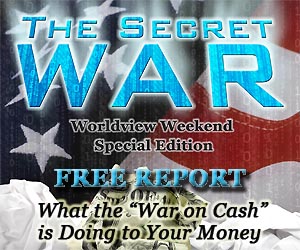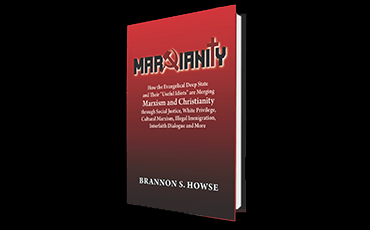America's Unknown Revolution That Robbed You of Your Rights
<?xml:namespace prefix = st1 ns = "urn:schemas-microsoft-com:office:smarttags" />America's Unknown Revolution That Robbed You of Your Rights By Brannon Howse<?xml:namespace prefix = o ns = "urn:schemas-microsoft-com:office:office" />
The following is from Brannon's best selling book, One Nation Under Man? The Worldview War Between Christians and the Secular Left. Click here to order this book now.
Introduction: A little known American revolution occurred with a U.S. Supreme Court decision in 1940, 1943 and 1947. With each of these three U.S. Supreme rulings, America's Constitution was turned on its head. The Ten Bill of Rights that were to be ten handcuffs that restrained the federal government were removed and placed on the states and each individual. Now Oklahoma has had enough and is telling the federal government to back off and honor the Tenth Amendment and state rights. A federal judge has told Oklahoma that their tough law that cracks down on illegal aliens is not acceptable to the almighty federal nanny.
If enough Americans would pull their heads out of their TVs and get up to speed on the Founder's original intent and only elect people to office that agree to restore the 10 handcuffs onto the federal government, we might avoid the growing tyranny from D.C. and the courts. So with that challenge, e-mail this article to every friend you know. Article:
The changes that bloomed in the 1960s actually began about twenty years earlier. In 1947, the U.S. Supreme Court issued a ruling in the case of Everson vs. Board of Education, concerning whether it was constitutional for tax funds to pay for the transportation of students to a private, religious school. While it did not find it unconstitutional, the Court did, for the first time, use Thomas Jefferson's "wall of separation" phrase completely out of context. David Barton notes, "That Court, unlike previous courts, did not give the context of Jefferson's letter, and did not even mention that previous Supreme Courts had used Jefferson's letter to preserve religious values in public society. That 1947 Court was the first to use Jefferson's metaphor completely divorced from its context and intent."46
While it was troubling for the Court to use Jefferson's words out of context, the most disturbing part of the Everson case was the silent revolution the Court thus began. For all practical purposes, the justices held their own constitutional conventions in the 1940s (the first of a number of "Court conventions") in which they eliminated the Tenth Amendment and stripped every state in the Union of their constitutionally protected freedoms.
In Original Intent, David Barton explains the consequences America suffers to this day from the Everson decision:
In Everson, the Court took the Fourteenth Amendment (which dealt with specific State powers) and attached to it the First Amendment's federal provision that "Congress shall make no law respecting an establishment of religion."
The result of merging these two Amendments was twofold: first, the Court reversed the bedrock constitutional demand that the First Amendment pertain only to the federal government; second, the Court declared that federal courts were now empowered to restrict not only the religious activities of the federal government but also those of States and individuals as well. The expansion of the Court's jurisdiction in the Everson decision was accomplished only by direct violations of the purpose for which both the First and Fourteenth Amendments were enacted.47
U.S. Supreme Court Justice William Douglas, in Walz vs. Tax Commission (1970), comments on what he views as a "revolution" resulting from the unconstitutional linking of the First and Fourteenth Amendments: "reversing the historic position that the foundations of those liberties rested largely in State law. . . . [T]he revolution occasioned by the Fourteenth Amendment has progressed as Article after Article in the Bill of Rights has been [selectively] incorporated in it [the Fourteenth] and made applicable to the States."48
Of the delegates that attended the Constitutional Convention in Philadelphia in 1787, only thirty-nine out of fifty-five signed the Constitution. Many of those who refused to sign the Constitution did so because they believed the Constitution did not contain the safeguards necessary to keep the central government in check. In addition, several states barely approved the Constitution, and North Carolina refused to ratify it until stricter limits were placed on the power of the federal government-to keep it from trampling the rights of the states.
In George Washington's first inaugural address, he asked Congress to amend the U.S. Constitution so as to further protect our freedoms, and on December 15, 1791, the first ten amendments-the Bill of Rights-were ratified. These amendments were designed as ten handcuffs placed on the central government to limit its power and protect the God-given rights of the states and their people. In other words, the Bill of Rights was intended to protect the states from tyranny by the federal government.
Samuel Adams described this purpose when he wrote, "to see a line drawn as clearly as may be between the federal powers vested in Congress and distinct sovereignty of the several States upon which the private and personal rights of the citizens depend. Without such distinction there will be danger of the Constitution issuing imperceptibly and gradually into a consolidated government over all the States. . . . [T]he population of the U.S. live in different climates, of different education and manners, and possessed of different habits and feelings [and] under one consolidated government cannot long remain free."49
Beginning in 1940, in the case Cantwell vs. Connecticut then in 1943, in Murdock vs. Pennsylvania, and finally in 1947, through Everson vs. Board of Education, the U.S. Supreme Court re-defined the Fourteenth Amendment and laid the foundation for the silent revolution. .
The damage done to the Fourteenth Amendment centers on this phrase: "All persons born or naturalized in the United States and subject to the jurisdiction thereof, are citizens of the United States and of the State wherein they reside. No State shall make or enforce any law which shall abridge the privileges or immunities of citizens of the United States."50
David Barton explains how the Court amended the Constitution and, by fiat, gathered unto itself unlimited-and unprecedented- power over every state in the Union: "In those decisions, the Court declared that the purpose of the Fourteenth Amendment was to limit the States not just on racial civil rights issues, but on the numerous items contained within the Bill of Rights. Under this reshaped purpose of the Fourteenth-and thereby under its new extended scope of power-the First Amendment would now limit every State and community, and no longer just the federal government as originally intended."51
With the 1940 (Cantwell vs. Connecticut), 1943 (Murdock vs. Pennsylvania), and 1947 (Everson vs. Board of Education) U.S. Supreme Court decisions, the Court took off the handcuffs that had restrained the federal government's power and placed those cuffs on the states. Now the federal courts were empowered to decide when and what rights the states could practice.
Once the Fourteenth Amendment was misapplied by the Court-and Congress allowed it to stand-the Court was free to apply the Fourteenth Amendment to the First Amendment as it did in the Everson vs. Board of Education. What followed was a series of natural steps further in the direction of judicial tyranny.
As the Founders debated the First Amendment, they agreed the First Amendment was crafted solely for the purpose of prohibiting the federal government from establishing a church or national denomination. They were equally clear that if the people of any particular state wanted to establish a state church of their own, the state government was free to do so. Supreme Court rulings from 1947 through 2000, though, have relentlessly attacked that freedom. The Court has now succeeded in outlawing state-sponsored prayer in schools, Bible reading, the posting of the Ten Commandments, and student-initiated prayer. The Founding Fathers would be appalled that judges were allowed to so ruthlessly use the Constitution to strip the states of their God-given rights.
The following is from Brannon's best selling book, One Nation Under Man? The Worldview War Between Christians and the Secular Left. Click here to order this book now.
Footnotes:
46 Barton, The Foundations of American Government, 10.
47 Barton, Original Intent, 17.
48 Walz vs. Tax Commission, 397 U.S., 701703 (1970); Douglas, J. (dissenting).
49 Samuel Adams, The Writings of Samuel Adams, Harry Alonzo Cushing, ed., vol. 4 (New York: G. P. Putnam's Sons, 1908), 332, letter to Elbridge Gerry.
50 Fourteenth Amendment, U.S. Constitution.
51 Ibid., 198.
Support Our Broadcast Network
Trending Stories
Latest
We're a 100% Listener Supported Network
3 Simple Ways to Support WVW Foundation
Make Monthly Donations
-or-
A One-Time Donation
-
Mail In Your Donation
Worldview Weekend Foundation
PO BOX 1690
Collierville, TN, 38027 USA -
Donate by Phone
901-825-0652


















